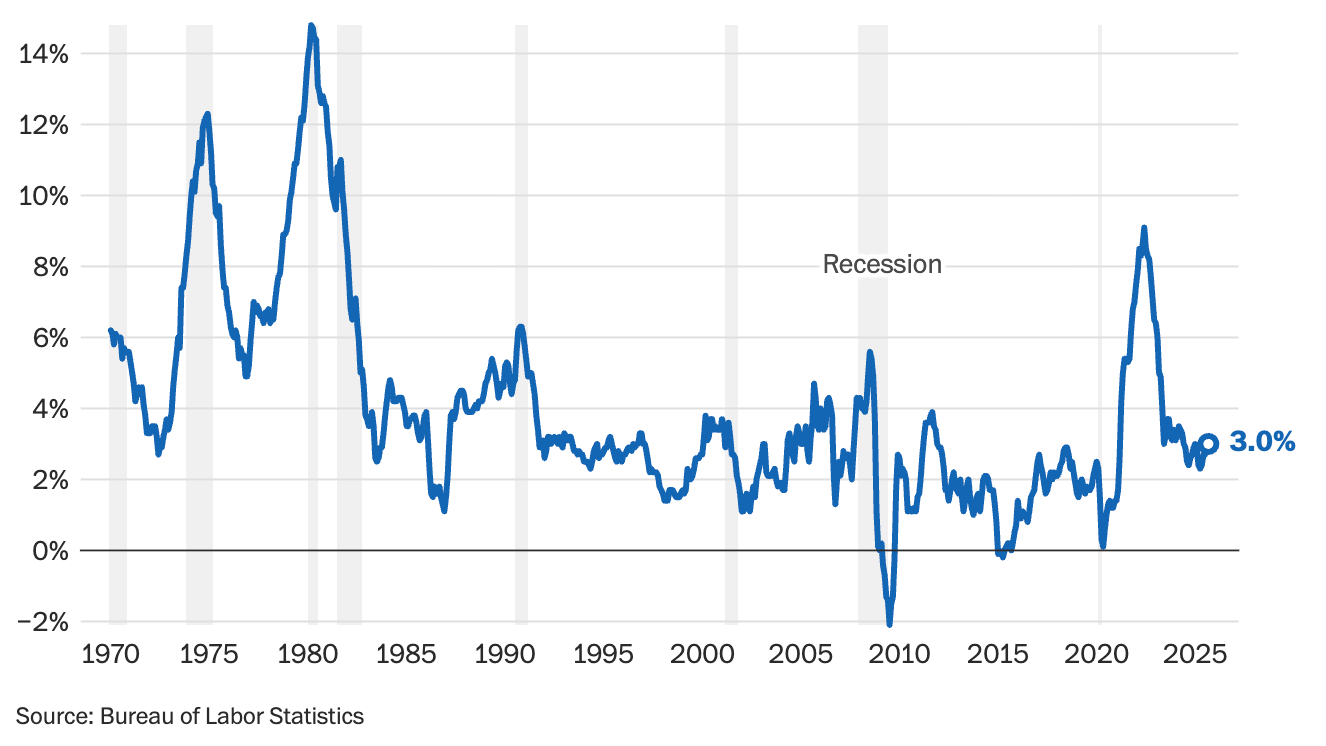National News
The consumer price index rose at a 3 percent annual rate, the government reported.

New data released Friday showed inflation heated up in September to a pace not seen since January, according to the first dataset to be released during the government shutdown.
The September consumer price index showed prices rising at a 3 percent annual rate — up slightly from 2.9 percent in August and above April’s post-pandemic low of 2.3 percent, according to the Bureau of Labor Statistics.
Gasoline prices, which edged down over the past year — providing some relief to consumers — nonetheless jumped 4.1 percent in September and were the largest factor in a 0.3 percent monthly increase.
Core inflation, which excludes food and energy and is seen as a steadier gauge of underlying pressures, eased slightly to a 3 percent annual rate.
Annual inflation rate, consumer price index

The report offers the only official glimpse of the economy this month amid the government shutdown, highlighting the continuing impact of President Donald Trump’s tariffs on consumers, some of which began to take effect in August.
Though the 3 percent pace was slightly below economists’ expectations, Friday’s report is the latest to demonstrate that inflation hasn’t gone away and remains stubbornly above pre-pandemicnorms. The long stretch of above-average increases has left the cost of everyday goods and services about 25 percent higher than before the pandemic.
Some categories with exposure to tariffs, such as apparel and furniture, notched gains. Other goods prices showed increases, particularly for food, which rose 0.2 percent in September and was up 3.1 percent since last year.
Broadly though, tariffs don’t fully explain the rise in inflation, which is still largely driven by a 3.6 percent annual rise in the prices of services such as housing, fuel and utilities, according to Joe Brusuelas, chief economist at RSM. Though shelter price inflation slowed in September, it was up 3.6 percent for the year.
Michael Pearce, deputy chief U.S. economist at Oxford Economics, said in a research note that September’s smaller-than-expected rise in consumer prices gives the green light for the Federal Reserve to cut rates at its policy meeting next week. But he expected the Fed would slow the pace of future cuts as long as inflation remains closer to 3 percent, well above its 2 percent goal.
White House press secretary Karoline Leavitt noted that Friday’s report showed inflation came in just below economists’ expectations. “This is good news for American families,” she wrote on X.
The shutdown would likely prevent the government from releasing an inflation report for October, she added.
The White House says inflation is actually running at a 2.5 percent pace, well below the annual figures that appear in headlines. That estimate is based on a method called “annualization,” which projects a full year’s change from a shorter period. In this case, the administration calculated its 2.5 percent figure by looking at how much the consumer price index rose between January and September and assuming that trend continues for a full year. That method is unusual, and experts say it isn’t typically able to pin down the true direction of inflation, which can be swayed in the short term by one-off events.
Friday’s inflation report was originally due Oct. 15, but was postponed after the shutdown furloughed most Bureau of Labor Statistics staff. The White House later recalled key employees to finish the report, which is needed to calculate the annual cost-of-living adjustment for Social Security recipients. Social Security recipients will see a 2.8 percent cost-of-living increase in their monthly checks next year, the agency confirmed.
Despite sweeping tariffs, higher costs have filtered into consumer prices more slowly than expected. Many duties didn’t take effect until weeks or months after the announcement, and companies stockpiled goods before the levies hit — inventories that are now largely depleted. This summer, consumer prices began rising across a broader range of goods.
The economic picture is complicated by signs of cooling elsewhere. Revisions to government labor data show U.S. employers added far fewer jobs over the summer than initially reported, underscoring a loss of momentum even before new tariffs and immigration policies began squeezing business costs. Hours after the Bureau of Labor Statistics released a set of large monthly revisions on Aug. 1, Trump fired the agency’s director, an extraordinary move that deepened concerns about political interference in economic data. The BLS isn’t expected to release jobs data during the shutdown.
Though the latest jobs data has also been delayed by the shutdown, perceived weakness in the labor market led the Federal Reserve to trim interest rates last month for the first time this year. Markets expect additional cuts at the two remaining policy meetings this year, including next week.
Nathan Sheets, chief economist at Citigroup, said the Fed is taking a cautious approach. Inflation is largely under control, but concerns are rising about a weakening labor market. The upshot is that cutting rates now is intended to make it easier for companies to hire, supporting a jobs market that is starting to soften without spurring excessive inflation.
“As they cut, they’re not putting their foot on the accelerator,” Sheets said. “What they’re doing is they’re just not pumping the brake as hard as they were before.”
Inside the Fed, some officials say tariffs will nudge up prices in the near term, but they aren’t expected to cause a long-term rise in the overall rate of inflation. Because of that, the Fed shouldn’t let temporary price jumps from tariffs change its broader policy decisions — it can afford to “look through” these short-term effects and focus on the bigger picture of inflation.
“My base case is that tariffs will increase the price level, but they won’t leave a lasting imprint on inflation,” Philadelphia Fed President Anna Paulson, said in a speech last week. “And, given this base case, monetary policy should look through tariff effects on prices.”
Extra News Alerts
Get breaking updates as they happen.



